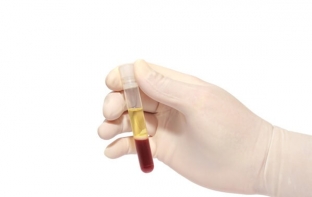Every year, facial rejuvenation techniques using autologous platelet-rich plasma are being used more and more and confidently occupy a worthy place in the practice of a doctor of aesthetic medicine. Estet-portal.com reviewed several cases of using the plasma therapy technique given in world scientific publications, and invites you to join the conversation about how and in what cases the use of autologous platelet-rich plasma is most effective.
What are platelets for and how do they enrich autologous plasma
A platelet is a disc-shaped cell with a smooth membrane. In the body, a platelet performs very important functions, among which, for estheticians, in the first place, it is important to initiate tissue repair, regulate local immunity and influence the course of inflammatory reactions. In the cytoplasm of an inactive platelet, there are various types of granules, including alpha granules containing, among other essential elements for the body, various growth factors – platelet, transforming, epithelial, endothelial growth factor. In order for these growth factors to be released from the alpha granules and begin to work, the platelet must be activated.
Their contact with the subendothelial structures of the vascular walls can activate platelets – collagen, microfibrils. At the same time, the disc-shaped shape of the platelet changes to a spherical one, processes are formed in them, and activated platelets adhere to the collagen fibers, starting to throw out the elements stored inside, including growth factors, stimulating tissue renewal.

How does autologous platelet-rich plasma affect the skin
For plasma therapy, autologous plasma obtained from the patient's blood and enriched with platelets (PRP) is used. To date, scientists have not yet reached a consensus on what concentration of platelets in enriched plasma is considered optimal.
An enriched plasma fraction is one in which the concentration of platelets is significantly higher than the baseline – modern methods of obtaining PRP allows to achieve 300-700% enrichment of the patient's autologous blood.
Due to such a high concentration of platelets, and hence all the resources contained in them, scientists are trying to maximize the activation of fibroblasts and the synthesis of collagen, other components of the extracellular matrix responsible for skin rejuvenation.
In 2011, Korean scientists conducted a study on the effect of autologous platelet-rich plasma on fibroblast stimulation. They obtained fibroblasts from a skin flap and treated with activated PRP in a serum-free medium. As a result, increased cell proliferation and expression of collagen type 1 was observed, leading to the conclusion that PRP can be used for skin rejuvenation as an adjuvant therapy.
Another study was described in 2014 in the journal CosmeticandLaserTherapy: ten volunteers aged about 50 received three treatments with an interval of two weeks, during which they were injected with autologous platelet-rich plasma – with a mesoscooter all over the face and additional injections in the wrinkle area. As a result, the density of the skin increased significantly, the depth of wrinkles decreased, but there were no changes in pigmentation
Another interesting study was described in the same place in 2014. It involved 4 groups of patients who underwent facial lipofilling alone and in combination with PRP, MACS-lift operation alone and in combination with PRP, with lipofilling. Evaluated not only aesthetic changes, but also the rate of healing after surgery. It was noted that, firstly, the rehabilitation period in the PRP groups was 5 days shorter, and patients returned to their daily lives earlier. Secondly, due to PRP, angiogenesis and blood supply to tissues significantly increased, vascular sprouting significantly reduced the risk of adipose tissue necrosis, and tissue repair and healing accelerated.
It is very important that PRP can be used not only as an independent procedure, but also in combination with other methods, greatly enhancing their effectiveness.
Thus, the use of autologous plasma enriched with platelets at a concentration of at least 300% (depending on the power of the centrifuge) in combination with other methods allows you to achieve the maximum rejuvenating effect, reduce the rehabilitation time after a traumatic procedure and reduce the risk of complications.







Add a comment